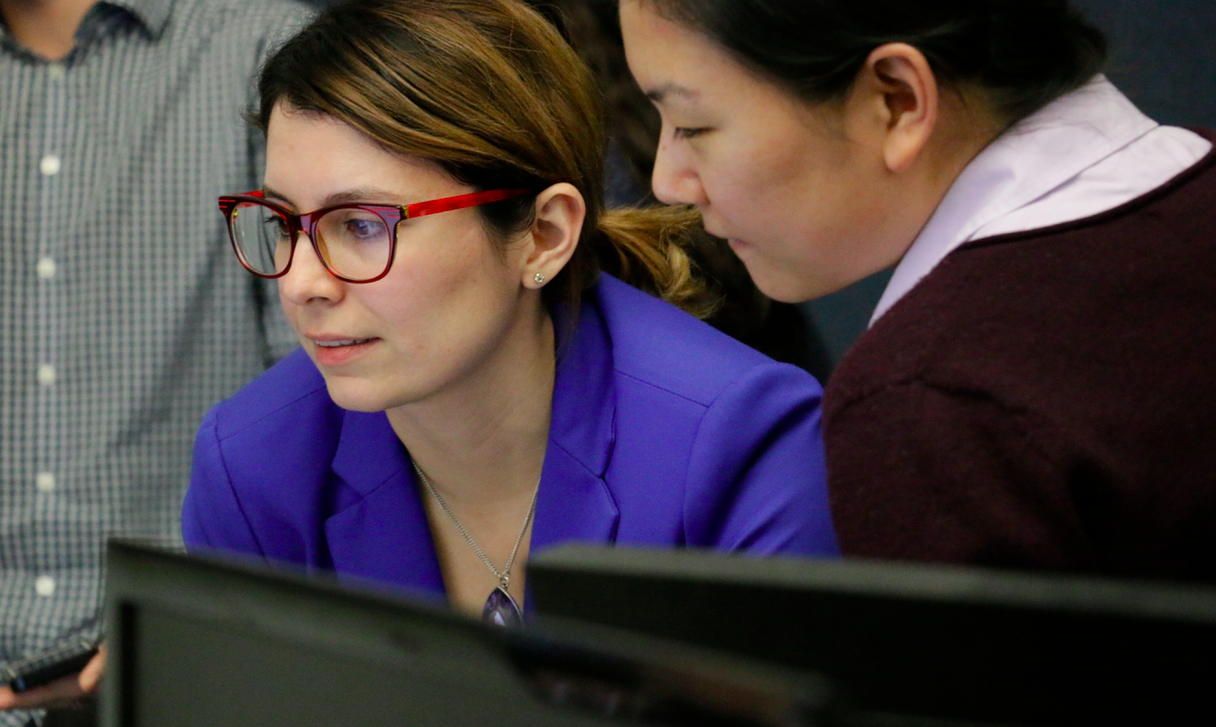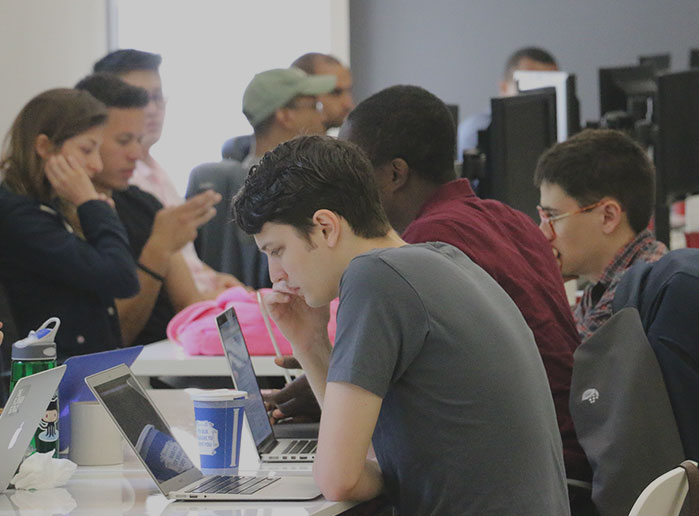By Kate Travers, Web Developer on Learn
I had to make the decision to leave my current job almost exactly a year ago. I’d spent most of my career working in the fine arts, but coding had always been a side passion — one that I found myself committing more and more of my time and energy towards. After a lot of soul searching and careful research, I decided to take the plunge. I put in my notice and enrolled in a full-time, in-person, three-month program in New York City (specifically, the Web Development Immersive at Flatiron School).
This was no small decision for me. I was leaving a successful career in my field, for which I had a Master’s degree and 4+ years of experience — for another field in which I had little to no academic or professional experience. Not something to be taken lightly.
But I did my research and gathered all the information I could to make a smart, informed decision. When the time came to make the jump, I knew I was doing the right thing. Here’s the advice I’d give anyone considering a similar decision:
Make sure you actually LIKE programming
This might be the most important point on the list. Make sure you’re making this change for the right reasons. Learning to program isn’t some guaranteed fast track to a higher salary or a multi-million-dollar startup deal. I’ve seen plenty of people jump in thinking they can go from zero to Mark Zuckerberg in a couple months — and those people never last. Learning to program is HARD, and to stick with it and be successful, you actually have to LIKE writing code. Like, want to spend 8/10/12 hours a day every day levels of liking it.
So figure that out first. Start doing some tutorials. Try out some free online courses like the intro tracks on Learn-Verified. Don’t worry if it’s hard at first or if you get stuck. Do you enjoy the challenge? Do you like fighting through problems until you solve them? If you get discouraged and find yourself drifting to back to your Netflix queue, then you might want to consider another path. But if you get real satisfaction out of building starter projects and solving tricky coding challenges, then you’re on the right track.
Get your finances in order
Quitting your job means foregoing a steady paycheck and benefits, so you’ll want to make sure you’re financially prepared to cover yourself until you can land a new job as a developer.
Set a schedule, then make a budget. If you’re teaching yourself, don’t set some ambiguous goal like “take a year off to learn to code”. Instead, map out a specific timeline and stick to it (for example, eight hours a day, six days a week for six months). One benefit of choosing an on-site program like Flatiron School or Hackbright Academy is the schedule will already be set for you. However, one benefit of choosing an online program is you may not have to quit your job in the first place to complete the program.
Whether you’re doing a self-guided or formal program, make sure you can cover essential expenses like rent, food, and travel costs for the full duration, plus at least three additional months for your job search. Keep in mind, three months is an optimistic benchmark for landing a new job. I knew I could budget based on that number because I attended Flatiron School, whose independently-verified jobs report boasts some amazing job placement numbers (95% of students placed within 120 days). But they’re the only school with independently verified numbers, so if you’re considering another school, it’ll be a little harder to confidently estimate how much you’ll need to budget during your job search.
Be sure to research available scholarships, either through the program you’re attending or through organizations like Girl Develop It and Operation Code, or even local government programs, like New York City’s iOS Mobile Dev Corps. If the program you’re considering doesn’t advertise any scholarships, ask anyway! There’s nothing to lose there.
Finally, you could also consider a peer-to-peer loan, via companies like Upstart or Prosper. These tend to have more favorable rates and reasonable terms for individuals.
Inform your support network
Don’t make this decision alone. Your choice is going to impact not just you, but everyone else in your life — your roommate(s), family, and friends. Make sure they’re aware of your plans, so they can be prepared to support you emotionality (and maybe even financially).
Most importantly, they need to be prepared to have less of you in their life. You’re going to be heads-down for the next few months (at least), focused only on learning to program and changing your life. This means fewer nights out at the bar, fewer weekend hangouts, just fewer social engagements all together. It’ll be a hard adjustment no matter what, but preparing everyone in advance will help.
Do your homework
Put the the time in researching what learning option is best for you.
Do you work better independently, when you can set your own schedule and pace? Maybe a self-paced online course is better for you than an in-person immersive.
Would you prefer to work from home, with an active online community of supporters? There are plenty of other things to consider too, like job placements and what kind of curriculum you’re interested in.
If you prefer the structure of an in-person program, choose one that aligns with your values. Look for one that’ll give you the support you need:
– Financially, through scholarships and payment plans
– In the classroom, through dedicated instructors and high-quality curriculum
– In your job search, through personalized support that delivers proven results
– After the course, by connecting you with mentors and an active alumni network
When speaking with different programs, ask them for the job placement numbers. Find out if they offer tutoring or mentorship programs, if they bring in guest speakers or help students connect with the larger developer community through Meetup events, presentations, and conference talks. Take an alumni out to coffee and get their first hand perspective. Read students’ blogs to get a sense of what they’re learning, what they’re building, and their general satisfaction with the course. Better yet, check out students’ GitHub profiles. Any reputable school should be able to connect you with an information on request.
Here are a few more posts on choosing the right coding program:
- What are the best online coding schools available?
- What other sites are there to learn coding interactively like Codecademy?
- What are the best programming bootcamps that last between 8-12 weeks?
Get to work
Once you have a start date, don’t just sit idly waiting for things to kick off. Instead, put in as much preliminary work in as you can. The more knowledge you have walking into the program, the more you’ll get out of it. Some of the best free / low-cost options include:
Flatiron School Pre-Work – The same coursework required for all students entering the Flatiron School immersive programs. Both Web Development and iOS courses available.
Codecademy, Treehouse, Code School – Online videos and exercises on a wide variety of programming topics, primarily web and iOS development. Codeacademy is entirely free, while Treehouse and Code School offer a mix of free and paid content (for a monthly subscription fee).
eBooks on programming – Not surprisingly, you can find an eBook on pretty much any programming topic you’re interested in. Zed Shaw’s Learn Code the Hard Way series is fantastic, and covers Ruby, Python, C, SQL, and Regex. Rubyists should check out The Bastard’s Book of Ruby, and JavaScript noobs should dive into Eloquent JavaScript.
Listen to podcasts – Some great coding podcasts include Code Newbies, Ruby Rogues, and Giant Robots. If you hear a guest you like, Google them. They’ll probably lead you to another good podcast.
Watch videos – Visual learners might prefer some of the great programming video series out there, like Ryan Bates’ Railscasts, Douglas Crockford’s Javascript series, and Avdi Grimm’s RubyTapas. Feel free to suggest more you find in the comments.
Overall, making the decision to quit my job and learn to code was (initially) terrifying, but turned out to be the best decision I’ve ever made. I’m working full-time as a web developer now, doing what I love and getting better as a person and a programmer every day. Here’s hoping the same for you!
Are you interested in learning programming online?

Kate Travers is a Brooklyn-based web developer and graphic designer. You can check out her website at kate-travers.com.
Written byFLATIRON SCHOOL
Make yourself useful.



